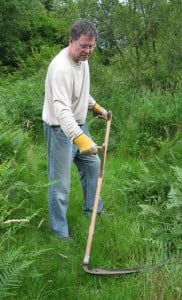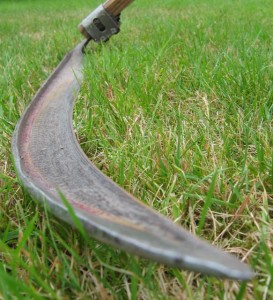It’s time that the strimmer’s infernal whine, insidious pollution and indiscriminate destruction made way for some real cutting-edge technology.
Which would you choose? A droning, finger-numbing, sweaty, headache-inducing frenzy amid a cloud of choking exhaust fumes, dust and dismembered bits of plants, insects and animals? Or a gentler, chiffchaff-serenaded approach that spares buzzing, scurrying, toe-level wildlife, and from which the only sounds are stone on steel and the swish of a razor’s edge slicing through grass?
One of the ‘bequests’ from the previous owner of my home was a large and heavy petrol-powered strimmer – the type where a forever-disappearing nylon cord feeds out from a central spool. I loathed the thing the moment I saw it. It had been used to ‘cut’ the grass and bracken which grows along my track, and so, thinking it would ‘make life easier’, I dutifully harnessed up, fuelled up and pulled the starter cord. Off I went – into a fossil-fuel-powered nightmare, both for me and for anything that couldn’t get out of my way fast enough. The biting straps of my steamed-up, dust-covered goggles kept me alert enough to see mice, voles and the odd frog scurrying for their lives as the infernal machine inflicted its slashed-earth policy wherever I pointed it. Plodding toads, clover-beguiled bees, darting beetles, and much more besides, stood no chance. Far from making life easier, this bone-shaker on a pole actually took life – indiscriminately, brutally and without warning.

After presiding over several more acts of mass slaughter, I’d had enough and bequeathed the wildlife-slasher to suburbia, where its Sunday-morning-wrecking whine would be lost among the competition. I didn’t care if I had to trim the grass by shuffling along crab-like on a kneeler, using only a pair of shears – anything would be better. And then I found something immeasurably better, which strips away the mundanity of grass-cutting and takes it to a beautiful new level, and without the ground-level massacres. I still break a sweat when I’m cutting the grass, but feelingless fingers and a banging head are long gone.
I’m uneasy with any gardening activity that is powered primarily by fossil fuels, whether it’s heating greenhouses or running lawnmowers, strimmers or any other ‘power tool’. It amazes me how readily we fall for the seductive ‘make life easier’-speak that’s got us doing daft things like blowing leaves around the lawn instead of using a rake. These boys’ toys are now used to groom our public spaces, which extends the drone to weekdays and helps us to forget that a well-crafted, gardener-powered tool can be an effective and more earth-friendly way to get things done.
Noxious as a mouthful of exhaust fumes is, there was something that bugged me more about that strimmer. After razing the track edges to the ground, I found the odd fragment of bright yellow nylon cutting cord. But given that there are several metres of cord on a spool, I found surprisingly few; the rest had disappeared into the grass, the soil, the stream. Aware of the pollution belching from one end of the strimmer, I grew mindful of that being flung out of the other. Together, all these whining toys and their countless metres of disintegrated cord (I could find no figures on how many strimmers are in use), are amassing quite some heap of pollution. Although it’s so well dispersed that we don’t see it, and quickly forget about it, strimmer cord’s longevity guarantees that a few centuries from now, gardeners will turn up evidence of our ‘easier’ ways as they tend the soils we have passed on. There is a chink of greener promise for strimmer cord: you can now buy a ‘biodegradable’ nylon which is broken down by soil microorganisms into inert, harmless substances (it’s claimed) in 12 to 36 months.
The day my scythe arrived, my slashed-earth policy ended, along with my qualms about polluting the air, the soil and the peace. It’s Austrian, with a steel blade and a lightweight ash handle or ‘snath’. It came with a whetstone to keep the blade sharp (‘honed’), and a ‘peening’ kit to ‘tap out’ the edge of the blade when it blunts after continuous use. Owning and using a scythe opens up a new and gentler, pollution- and massacre-free way of cutting long grass and weeds. I recommend visiting The Scythe Shop’s website where you can learn more.

One of the most wonderful things about a scythe is that it does exactly what you want it to do; the loud, uncontrolled frenzy of a ripping cord is replaced by the gentle, considered sweeping of a blade. There are no harnesses, and goggles aren’t obligatory (although a pair of tough boots and strong gloves are must-haves). You don’t so much use a scythe as work in unison with it. It can take a bit of time to master the art of allowing your body and the blade to move as one, but advice abounds on using scythes, and online videos give the basic gist. I use my scythe throughout the summer to cut long grass, bracken, and weeds such as dock, on my track, around the wild perimeter of my garden, and along a nearby footpath. It breaks into no one’s Sunday morning, leaves no pollution, tears no bark from trees, and gives overlooked muscles a welcome workout.
But the main reason I dote on my scythe is because it keeps me connected with what’s going on around me. I can still hear a cuckoo calling when I’m cutting, still hear a bumblebee foraging ahead, still sense the scurrying of a vole or a slow worm (and spot the grass twitching, too). I can brush the blade through the next patch to be cut, urging froglets, toadlets and the just-fledged to move on. I can halt mid-swish if a straggler turns up, as they often do. I can easily spare a lone foxglove, a patch of seeding primroses, a fern or a clump of ragged robin. I can work with ease on my bank, felling stands of soon-to-be-composted bracken with grace rather than through gritted teeth. The only blood I need shed is green sap.
My scythe also reconnects me with something else that ego-serving power tools have taken from us. It gives me the chance to be part of the process of getting a job done, rather than just being a two-legged taxi. It coaxes me to learn some basic skills, to practice and refine them, and to be eager to discover how I might improve. Above all, it encourages me to go about my gardening with tenderness, not apprehension.
Considered swish or bloodthirsty whine? You choose.
Text and images © John Walker


